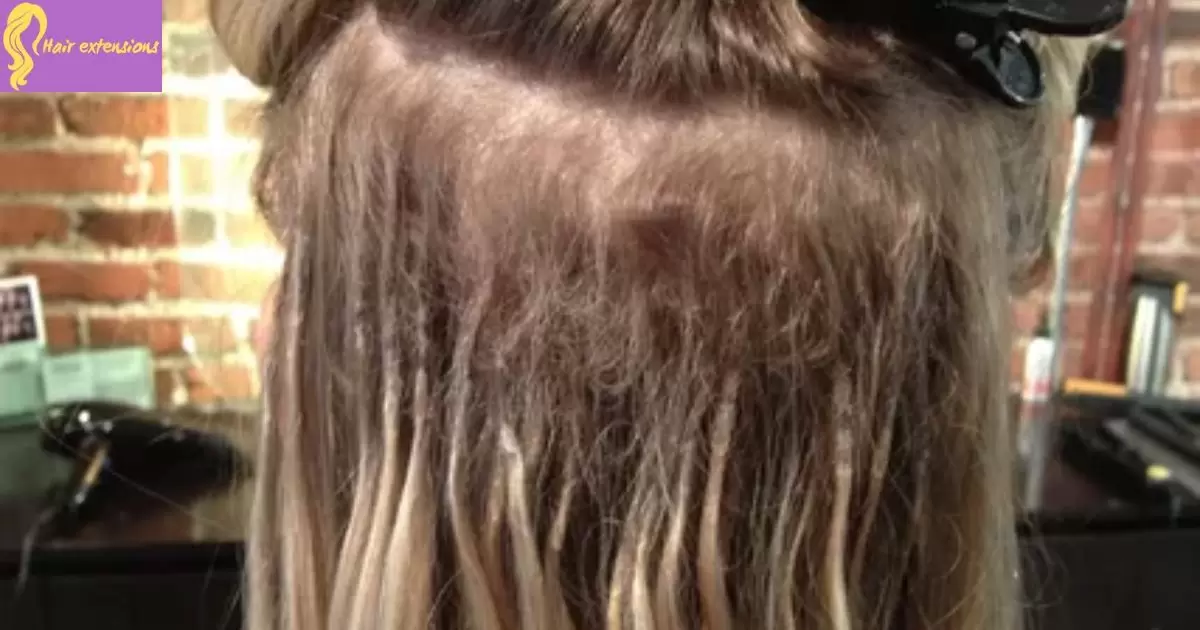When adding hair extensions, picking the least damaging method and materials prevents undue hair loss and breakage. Properly evaluating factors like hair type and lifestyle helps narrow suitable options. The right extensions augment natural hair without chemicals, excess bonds, or heavy weights that pull on follicles and cause trauma. Careful selection allows enjoying extensions’ benefits without damage.
Which hair extensions won’t wreck your hair? Some can really cause breakage and thinning. You want the cool look without the damage! Find out which type uses gentle bonds, stays secure but not too tight, and leaves your own locks healthy and strong. Ask yourself, Which Hair Extensions Are The Least Damaging?
Hair extensions should give you fuller, longer locks without damaging your natural hair. To avoid breakage and thinning, you need an option with gentle attachment methods, comfortable bonds, and lightweight materials. Tapes, clips, and loose weave-in extensions tend to be less traumatic than tight braids or chemical bonds. Considering hair type and lifestyle helps determine the least damaging method for you.
Clip-In Extensions Are The Overall Best For Preventing Hair Damage

When it comes to limiting damage, clip-in hair extensions come out on top. These extensions attach via fabric-covered clips that gently grip sections of natural hair without using bonding agents, adhesives or chemical treatments. This makes clip-ins a reversible option that won’t permanently alter your locks.
There are both synthetic and real human hair clip-in extensions available. While quality on both varieties runs the gamut, human hair types typically blend the most seamlessly for the most natural look. With either type, be sure to select styles with sturdy yet gentle clips that won’t pinch or snag the hair. Avoid extremely tight clipping and remove extensions gently to prevent excessive pulling or breakage over time.
Here’s a comparison of potential pros and cons of clip-in extensions:
Clip-In Extension Pros
- Don’t require permanent chemical bonds or adhesives
- Reversible – Won’t permanently mark or alter natural hair
- Easy to self-install and remove at home
- Can be worn indefinitely if cared for properly
Clip-In Extension Cons
- Placement can feel bulky with very thick hair
- May feel less secure than bonded extensions for active lifestyles
- Clips can potentially pinch or tug hair if cheaply made or improperly placed
Overall, as long as you opt for high-quality clips and are gentle when applying and removing them, clip-ins bring the least risk of damage with multiple wears. They can typically be integrated into haircare routines for many months without significant harm.
Tape-In Extensions Also Rate Low For Hair Damage

Tape-in hair extensions land close behind clip-ins when it comes to limiting damage. As the name denotes, these extensions attach using gentle yet durable double-sided adhesive tape bonded to small sections of natural hair. Like clip-ins, tape-ins don’t require permanent chemical treatments and are designed for short-term wear.
It’s best to have tape-in extensions initially installed and moved up by a trained stylist familiar with sectioning and aligning them properly. When correctly placed and cared for, high-quality tape-ins can often be worn 4-8 weeks before repositioning. Over that period, any excess tension on the follicles and potential drying effect from the adhesives should remain minimal.
Here is an overview of tape-in hair extension benefits and drawbacks:
Tape-In Extension Pros
- Allow for more scalp coverage than clip-ins
- Smooth flat application creates seamless look
- Tapes gentle on hair if correctly selected and applied
Tape-In Extension Cons
- Initial install requires professional training
- Need repositioning every 4-8 weeks to prevent damage
- Improper alignment can cause excess tension on hair
- Adhesive residue requires more cleansing to avoid buildup
While requiring a bit more maintenance, high-quality tape-ins with proper alignment change the look drastically while remaining gentle on strands. Schedule occasional salon touch-ups for preventative care.
Additional Tips For Preventing Hair Damage With Extensions

No matter which attachment method you select, you can take additional steps to guard the health of your natural hair under extensions:
- Seek silkier, less rigid extension clips and tapes to limit pulling
- Avoid applying extensions too tightly at the roots
- Give hair and scalp breaks by removing extensions at night
- Wash less frequently (1-2x per week) to prevent over-cleansing hair
- Use hydrating oils and masks between wears to nourish hair
- See a stylist promptly if extensions feel painful, pinching or too tight
- Schedule regular maintenance appointments for adjustment
Protecting your natural locks requires both choosing less abrasive extension methods and caring gently for hair overall. Being cautious and avoiding excessive tension will help you achieve beautiful added length with minimal fraying or thinning. Consult a knowledgeable hair stylist whenever questions arise.
Bonded Extensions Require More Maintenance To Prevent Hair Harm
Beyond clip-ins and tape-ins lie more semi-permanent options often called bonded extensions. These extension types use various chemical solutions, keratin bonds, beads, or even heating methods to attach longer hair directly to small sections of natural strands. While results can appear seamless when applied properly, the bonding process does carry higher risks of eventual damage over time if not cared for correctly.
Common bonding extension methods include:
- Hot Fusion Extensions: These use a bonding agent plus heat to fuse extension hair around natural locks. Fusion bonds must be moved up as your hair grows out to prevent detachment and damage.
- Keratin-Tip Extensions: Here a keratin “tip” connects to the natural hair, allowing extensions to be threaded through for a braided appearance. Buildup requires regular removal.
- Micro-Bead Extensions: Tiny metal or plastic beads clamp hanks of extension hair to natural locks. As hair grows out, beads must be removed and replaced.
- Nano-Ring/Loop Extensions: Mini metal rings secure small bundles of extension hair without using adhesives or heat. Must be moved up regularly as natural hair length increases.
All these bonding methods allow for lengthy wear when properly installed and routinely maintained. However, if alignment isn’t consistently monitored and adjusted, bonded extensions can definitely cause breakage. Their removal also tends to be lengthier and more labor-intensive than other methods.
Below are general pros and cons associated with bonded extension techniques to consider:
Bonding Extension Pros
- Create very natural, seamless look when applied correctly
- Allow for scalp coverage, ponytails, updos
- Provide long-lasting wear between maintenance checks
Bonding Extension Cons
- Can severely damage natural hair if aftercare is lacking
- Improper application and tension can cause friction and thinning hair over time
- Require meticulous precision and experience to install properly
- Must be routinely removed fully and reapplied/adjusted every 2-3 months
As seen above, while bonded extensions produce lasting, adaptable results at their best, inadequate maintenance practically guarantees eventual damage. Being extremely selective about your stylist plus staying on top of recommended aftercare is critical for avoiding excess harm over their wear span.
Synthetic Hair Alternatives Present Lowest Risk But May Be Less Versatile

| Extension Type | Hair Used | Damaging? | Styling Options | Cost |
| Synthetic | Fake hair fibers | No, attaches without bonds | Limited heat use | $ (cheapest) |
| Clip-ins | Real human hair | No, less bonds | High heat flexibility | $$ |
| Tape-ins | Real human hair | A little, bonds to hair | High heat flexibility | $$ |
| Bonded | Real human hair | Yes, high chemical/heat bonds | High heat flexibility | $$$ (priciest) |
Beyond human hair extensions lie fully synthetic wig or hairpiece options if limiting damage is your top priority. High-quality synthetics like heat-friendly fiber “Smart Hair” are designed to mimic the look and texture of real hair while allowing for heat styling. Such synthetic pieces clip, tape or even adhere directly to natural hair without chemicals. Hair Extensions Itchy issues sometimes arise from improper care or sensitivities to certain adhesives. Ensuring proper removal, cleaning and storage helps reduce itching.
Here’s an overview of the upsides and downsides common to quality synthetic hair extensions and alternatives:
Synthetic Extension Pros
- Prevent natural hair from being damaged via attachment
- Require little ongoing maintenance or removal processes
- Cost for materials often most budget-friendly
Synthetic Extension Cons
- Don’t always emulate texture of real human hair
- Can’t be re-styled or heat treated to the same extent
- May appear less realistic depending on application method
For those whose overall hair health trumps creating the most natural-looking extensions, quality synthetics still represent a versatile choice. Clip-in synthetic styles also make great temporary solutions before committing to a potentially more damaging install.
FAQs
What is the healthiest type of hair extension?
The healthiest type of hair extension is clip-ins because they don’t require chemicals or heat.
What are the lowest maintenance hair extensions?
The lowest maintenance hair extensions are synthetic clip-ins since they rarely need styling or adjustment.
Which hair extensions are kindest to hair?
The kindest hair extensions to natural hair are clip-ins or tape-ins when properly selected and installed without excessive tension.
Are micro bead hair extensions damaging?
Yes, micro bead hair extensions can be damaging over time if not properly maintained.
Conclusion
Clip-in hair extensions pose the lowest risk for damage to natural hair as they don’t require glues or heat application. Clip-ins can be put in and taken out daily without manipulation. Tape-in extensions adhesive can stress hair with long-term wear. Micro links and keratin bonds involve more tension on hair than clip-ins.
Figuring out Which Hair Extensions Are The Least Damaging? comes down to avoiding tension, glue, and heat. Clip-in extensions check all those boxes. While convenient, other methods carry more risks of breakage and thinning over time.

